Wednesday, 30 May 2012
The Knowledge Graph: things, not strings
Search is a lot about discovery—the basic human need to learn and broaden your horizons. But searching still requires a lot of hard work by you, the user. So today I’m really excited to launch the Knowledge Graph, which will help you discover new information quickly and easily.
Take a query like [taj mahal]. For more than four decades, search has essentially been about matching keywords to queries. To a search engine the words [taj mahal] have been just that—two words.
But we all know that [taj mahal] has a much richer meaning. You might think of one of the world’s most beautiful monuments, or a Grammy Award-winning musician, or possibly even a casino in Atlantic City, NJ. Or, depending on when you last ate, the nearest Indian restaurant. It’s why we’ve been working on an intelligent model—in geek-speak, a “graph”—that understands real-world entities and their relationships to one another: things, not strings.
The Knowledge Graph enables you to search for things, people or places that Google knows about—landmarks, celebrities, cities, sports teams, buildings, geographical features, movies, celestial objects, works of art and more—and instantly get information that’s relevant to your query. This is a critical first step towards building the next generation of search, which taps into the collective intelligence of the web and understands the world a bit more like people do.
Google’s Knowledge Graph isn’t just rooted in public sources such as Freebase, Wikipedia and the CIA World Factbook. It’s also augmented at a much larger scale—because we’re focused on comprehensive breadth and depth. It currently contains more than 500 million objects, as well as more than 3.5 billion facts about and relationships between these different objects. And it’s tuned based on what people search for, and what we find out on the web.
The Knowledge Graph enhances Google Search in three main ways to start:
1. Find the right thing
Language can be ambiguous—do you mean Taj Mahal the monument, or Taj Mahal the musician? Now Google understands the difference, and can narrow your search results just to the one you mean—just click on one of the links to see that particular slice of results:
This is one way the Knowledge Graph makes Google Search more intelligent—your results are more relevant because we understand these entities, and the nuances in their meaning, the way you do.
2. Get the best summary
With the Knowledge Graph, Google can better understand your query, so we can summarize relevant content around that topic, including key facts you’re likely to need for that particular thing. For example, if you’re looking for Marie Curie, you’ll see when she was born and died, but you’ll also get details on her education and scientific discoveries:
How do we know which facts are most likely to be needed for each item? For that, we go back to our users and study in aggregate what they’ve been asking Google about each item. For example, people are interested in knowing what books Charles Dickens wrote, whereas they’re less interested in what books Frank Lloyd Wright wrote, and more in what buildings he designed.
The Knowledge Graph also helps us understand the relationships between things. Marie Curie is a person in the Knowledge Graph, and she had two children, one of whom also won a Nobel Prize, as well as a husband, Pierre Curie, who claimed a third Nobel Prize for the family. All of these are linked in our graph. It’s not just a catalog of objects; it also models all these inter-relationships. It’s the intelligence between these different entities that’s the key.
3. Go deeper and broader
Finally, the part that’s the most fun of all—the Knowledge Graph can help you make some unexpected discoveries. You might learn a new fact or new connection that prompts a whole new line of inquiry. Do you know where Matt Groening, the creator of the Simpsons (one of my all-time favorite shows), got the idea for Homer, Marge and Lisa’s names? It’s a bit of a surprise:
We’ve always believed that the perfect search engine should understand exactly what you mean and give you back exactly what you want. And we can now sometimes help answer your next question before you’ve asked it, because the facts we show are informed by what other people have searched for. For example, the information we show for Tom Cruise answers 37 percent of next queries that people ask about him. In fact, some of the most serendipitous discoveries I’ve made using the Knowledge Graph are through the magical “People also search for” feature. One of my favorite books is The White Tiger, the debut novel by Aravind Adiga, which won the prestigious Man Booker Prize. Using the Knowledge Graph, I discovered three other books that had won the same prize and one that won the Pulitzer. I can tell you, this suggestion was spot on!
We’ve begun to gradually roll out this view of the Knowledge Graph to U.S. English users. It’s also going to be available on smartphones and tablets—read more about how we’ve tailored this to mobile devices. And watch our video (also available on our site about the Knowledge Graph) that gives a deeper dive into the details and technology, in the words of people who've worked on this project:
We hope this added intelligence will give you a more complete picture of your interest, provide smarter search results, and pique your curiosity on new topics. We’re proud of our first baby step—the Knowledge Graph—which will enable us to make search more intelligent, moving us closer to the "Star Trek computer" that I've always dreamt of building. Enjoy your lifelong journey of discovery, made easier by Google Search, so you can spend less time searching and more time doing what you love.
Friday, 25 May 2012
How to correct map errors in Google Earth
We get a lot of emails from users asking us to correct data errors in Google Earth -- incorrect road names, mis-marked addresses, etc. We can't do that directly, but fortunately Google has a great solution to help you out.
To start, you don't actually fix the errors in Google Earth; you fix them in Google Maps, and those corrections are synced into Google Earth over the course of a few weeks.
To suggest a correction, simply right-click on an area inside of Google Maps and choose "Report a problem". The following screen will pop-up and will walk you through the process:
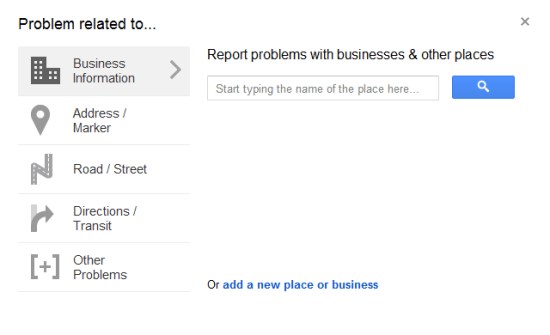 I've suggested quite a few edits to my local area, and all have been accepted into Google Earth/Maps and helped make my town more accurate. It's a great tool to help make Google products more accurate for everyone. To learn more about how this process works, you can visit this page in the Google Maps support system.
I've suggested quite a few edits to my local area, and all have been accepted into Google Earth/Maps and helped make my town more accurate. It's a great tool to help make Google products more accurate for everyone. To learn more about how this process works, you can visit this page in the Google Maps support system.
 I've suggested quite a few edits to my local area, and all have been accepted into Google Earth/Maps and helped make my town more accurate. It's a great tool to help make Google products more accurate for everyone. To learn more about how this process works, you can visit this page in the Google Maps support system.
I've suggested quite a few edits to my local area, and all have been accepted into Google Earth/Maps and helped make my town more accurate. It's a great tool to help make Google products more accurate for everyone. To learn more about how this process works, you can visit this page in the Google Maps support system.
A world of opportunity at the G(irls)20 Summit
We’re pleased to have Farah Mohamed join us today to talk about her organization, the G(irls)20 Summit, of which Google is a proud sponsor. The mission of the G(irls)20 Summit is to showcase how girls and women can impact a country’s economic prosperity, political stability and social innovation. - Ed.
Research shows that investing in girls and women can help the global economy. Consider the following examples:
- According to Plan UK, an extra year of education increases a girl’s income by 10 to 20% and is a significant step on the road to breaking the cycle of poverty.
- In Kenya, adolescent pregnancies cost the economy $500 million per year, while investing in girls could potentially add $32 billion to the economy (NIKE Foundation, 2009, Girl Effect).
- If men and women had equal influence in decision-making , an additional 1.7 million children would be adequately nourished in sub-Saharan Africa (International Labour Organization, 2009).
- Join us in Mexico City on May 28
- Sign up for your number in support of girls and women
- Join the conversation via our live stream on www.girls20summit.com on May 28, 29 and 31
Wednesday, 23 May 2012
Spain wins the 2012 Model Your Town Competition
We've talked about Pedro Domecq Aguirre, better known as "PeterG", quite a few times on here. He recently got some big news, and him and his teammate Josetxo Perez Fernandez were announced as the winners of Google's 2012 Model Your Town Competition!
Of the six finalists in the running, their models of Getaria, Gipuzkoa, Spain were voted as being the best. As you can see from the image below, they certainly did an awesome job:
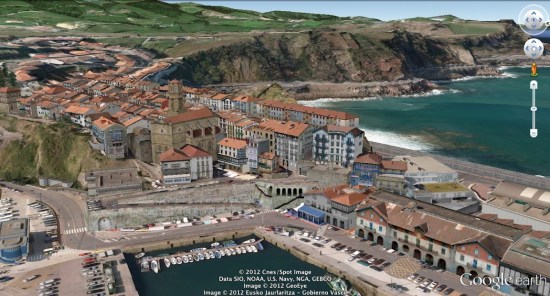 Their awesome work will help to show the world how great Getaria is, and it also earned a $25,000 prize to a local school!
Their awesome work will help to show the world how great Getaria is, and it also earned a $25,000 prize to a local school!
 Their awesome work will help to show the world how great Getaria is, and it also earned a $25,000 prize to a local school!
Their awesome work will help to show the world how great Getaria is, and it also earned a $25,000 prize to a local school!
Monday, 21 May 2012
Russian satellite brings us real-time Google Earth
We often get questions from users wondering how to access the "real-time Google Earth imagery". As you probably know, that doesn't yet exist. In fact, if you understand how Google Earth imagery works, you'll realize that we're a long way from a real-time version of Google Earth.
However, we're a small step closer to that goal with the release of a 121-megapixel image from a Russian satellite, the highest-resolution non-stitched image of the earth that has ever been captured:
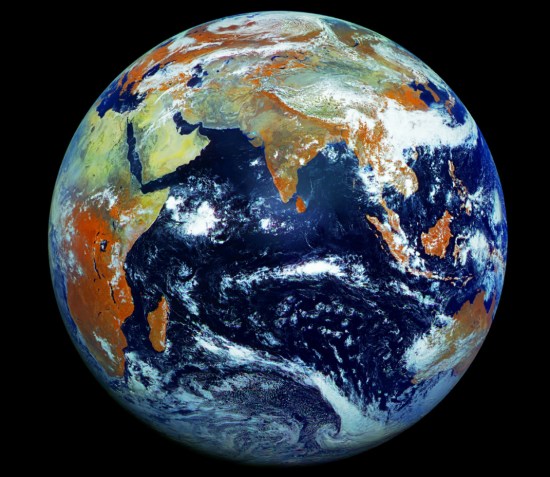 It seems likely that the only way to achieve a real-time Google Earth will be to have satellites capturing incredibly high-resolution images and transferring them back down to earth. While this image is certainly remarkable, it's roughly 1000 meters per pixel. Decent imagery in Google Earth is 1 meter per pixel (or better), so cameras will need to capture imagery at much higher resolution to make it work.
In addition to that, there's the issue of transferring the imagery to earth, properly aligning it, dealing with clouds, etc. We're still years away from a real-time Google Earth, but this has brought us one small step closer to it!
(via CNET)
It seems likely that the only way to achieve a real-time Google Earth will be to have satellites capturing incredibly high-resolution images and transferring them back down to earth. While this image is certainly remarkable, it's roughly 1000 meters per pixel. Decent imagery in Google Earth is 1 meter per pixel (or better), so cameras will need to capture imagery at much higher resolution to make it work.
In addition to that, there's the issue of transferring the imagery to earth, properly aligning it, dealing with clouds, etc. We're still years away from a real-time Google Earth, but this has brought us one small step closer to it!
(via CNET)
 It seems likely that the only way to achieve a real-time Google Earth will be to have satellites capturing incredibly high-resolution images and transferring them back down to earth. While this image is certainly remarkable, it's roughly 1000 meters per pixel. Decent imagery in Google Earth is 1 meter per pixel (or better), so cameras will need to capture imagery at much higher resolution to make it work.
In addition to that, there's the issue of transferring the imagery to earth, properly aligning it, dealing with clouds, etc. We're still years away from a real-time Google Earth, but this has brought us one small step closer to it!
(via CNET)
It seems likely that the only way to achieve a real-time Google Earth will be to have satellites capturing incredibly high-resolution images and transferring them back down to earth. While this image is certainly remarkable, it's roughly 1000 meters per pixel. Decent imagery in Google Earth is 1 meter per pixel (or better), so cameras will need to capture imagery at much higher resolution to make it work.
In addition to that, there's the issue of transferring the imagery to earth, properly aligning it, dealing with clouds, etc. We're still years away from a real-time Google Earth, but this has brought us one small step closer to it!
(via CNET)
Sunday, 20 May 2012
What Should You Tell A Client When Google Loses Their Reviews
Google continues having technical issues with losing reviews particularly when the CID of a listing changes due to a merge. Also they seem to be tightening down what appears to be a relatively unsophisticated spam algo (first confirmed in November 2010) that is catching a number of good reviews with the bad.
Don Campbell, amongst many others over the past few days, asked me what to tell rightfully upset clients that lose reviews from their Google Places page.
Here is what do when I have a client that has lost reviews:
1) Educate the client: I refer people to this Google authored article, Having technical issues with the reviews on your listing? In it Google outlines most of the issues as to why reviews go missing. The issues range from spam abatement to Google simply losing them in certain situations. Google notes that in most situations there is often little to be done even by The Google themselves until the issues are fixed and appropriate tools are developed. (In fact it really make the most sense to educate your client BEFORE they lose reviews so that they know what to expect and when it does happen you are not the one that they take their frustration out on.)
2) Provide a dose of humor and reality: Since there is not much a client or SEO can do, I also I provide them with the 6,6,6 rule for lost reviews to guide them as to what to expect in terms of recovery of the reviews. It might provide some small comfort.
What is the 6,6,6 review rule? (any client imagined thoughts about the devil suggested by my guideline are actively encouraged)
If reviews don’t come back to the Google Places page in 6 days, they might return in 6 weeks
If they don’t return in 6 weeks they might return in 6 months
If they don’t return in 6 months they have descended to Dante’s 6th Ring of Hell
3) Encourage them to stick with the plan: Regardless of what Google is doing (or more likely not doing) in regards to reviews this week, the best tactic is to keep on truckin’… continue to get more reviews at both Google AND 3rd party sites. I know it is hard and discouraging when difficult to obtain reviews are lost but neither the client (nor we) can control what Google does. The client can, in the end, only control what they do. It is better to have some reviews rather than none. A steady stream of reviews at the review sites will guarantee that the business has a solid review base no matter what and no matter whether Google has lost em again.
4) Advise the business to take control of their own destiny: (Contributed by Jacob Puhl) With the realization that some percentage of reviews will likely continue to disappear, the client should take it upon themselves to make copies of the reviews they do recieve at Google. If the reviews do disappear repurpose those that disappeared as testimonials on the client web site. In the same vein, implement hReview/Schema.org formatted testimonials on your site to highlight these “lost” reviews so that there is the chance of getting the additional review stars in search. Be sure that the testimonial page has enough prominence that there is a chance that it will be used by Google as a review page.
Reviews are hard to come by and painful to lose but just because Google doesn’t have their act together doesn’t mean that your client shouldn’t either. The value of reviews in terms of increased credibility & conversions is too high for the SMB to just give up on the process when confronted with adversity.
The Terbuka University in 3D
Over the past few years we've seen a variety of 3D University maps in different formats, including Harrisburg, Cantabria, Central Florida, Duke, Northeastern, Bowling Green and many others. The latest is a slick 3D map developed by Exist.inc from a variety of Universities in Indonesia, including Tebuka University.
developed by Exist.inc from a variety of Universities in Indonesia, including Tebuka University.
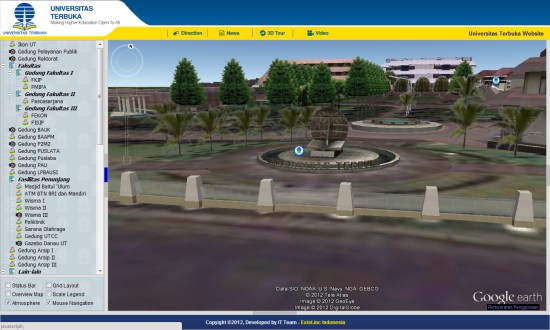 Along with the excellent interface using the Google Earth Plug-in, Exist is also the company behind all of the excellent 3D models for the campus. All of the models are in the main 3D Buildings layer in Google Earth, and they look great!
Along with the excellent interface using the Google Earth Plug-in, Exist is also the company behind all of the excellent 3D models for the campus. All of the models are in the main 3D Buildings layer in Google Earth, and they look great!
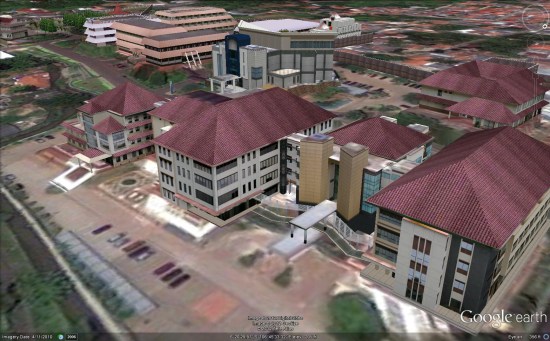 You can explore them for yourself by using this KML file.
You can explore them for yourself by using this KML file. Be sure to check out Google Earth Plugin-powered version at www.ut.ac.id/unit/3d.
Be sure to check out Google Earth Plugin-powered version at www.ut.ac.id/unit/3d.
 Along with the excellent interface using the Google Earth Plug-in, Exist is also the company behind all of the excellent 3D models for the campus. All of the models are in the main 3D Buildings layer in Google Earth, and they look great!
Along with the excellent interface using the Google Earth Plug-in, Exist is also the company behind all of the excellent 3D models for the campus. All of the models are in the main 3D Buildings layer in Google Earth, and they look great!
 You can explore them for yourself by using this KML file.
You can explore them for yourself by using this KML file.
Subscribe to:
Posts (Atom)


